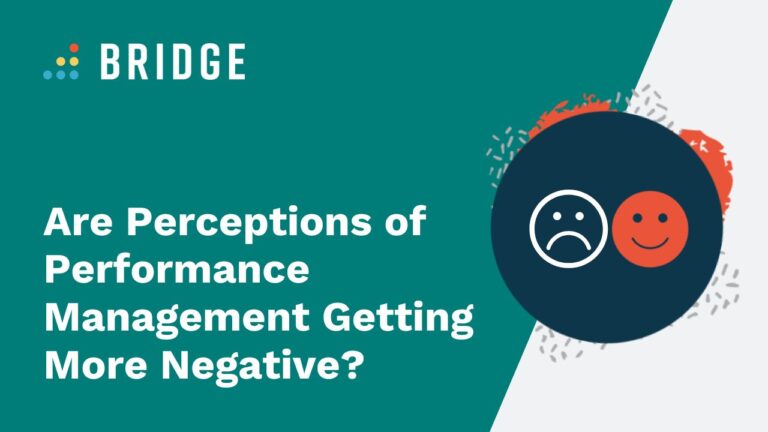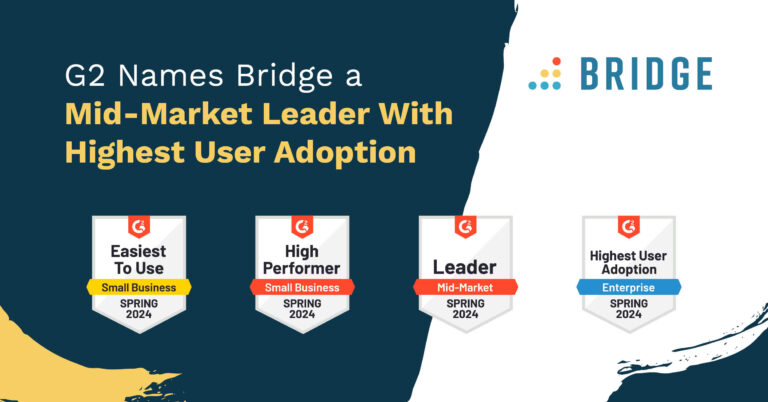According to Bridge-sponsored research, there’s been a significant drop in the perceived effectiveness of performance management (PM). You don’t have to be an HR or L&D whiz kid to know that this isn’t good news. As the name suggests, performance improvements are a key objective of any performance management program.
Crucially, these apparent drops in performance have been accompanied by a string of perceived decreases across a range of performance-related outcomes. Between 2022 and 2023, there’s been a decline in the percentage of people who believe that their performance management processes led to a high or very high degree of:
- Improved employee development (35% to 28%)
- Increased employee engagement (37% to 31%)
- Improved employee retention (32% to 24%)
So, what’s causing this drop in the effectiveness of performance management? And what benefits does good performance management unlock? A few of the report’s key takeaways shine a light on these very questions. Let’s take a look!
Takeaway 1: Managers Lack Performance Management Training and Accountability
Performance management benefits from well-defined processes and thorough documentation—but it’s more than a mechanical exercise. Good PM is built on the human qualities of the managers that implement it, from the personal insights they derive from performance conversations to the responsibilities they hold in making sure employees are achieving their goals.
However, the report suggests that, in many organizations, managers aren’t sufficiently equipped for the task—which means their performance programs are built on shaky foundations. Just 31% of respondents agreed or strongly agreed that managers have received the right amount of PM training. What’s more, respondents who struggled most to achieve their PM goals were half as likely to hold managers accountable when compared to PM leaders—and without accountability, those managers will be far less incentivized to maintain a high standard.
As such, it’s no surprise that only 23% of respondents agreed or strongly agreed that the managers at their organizations are skilled at performance management in general—or that only 32% felt their managers are good at having performance-related conversations.
These figures are particularly concerning considering that, at 67%, manager ratings are the most common performance management metric reported by the survey respondents. While manager ratings can be considered flawed in themselves (since they’re prone to bias and subjectivity), these flaws can only be compounded by managers who aren’t sufficiently up to speed on their performance management skills.
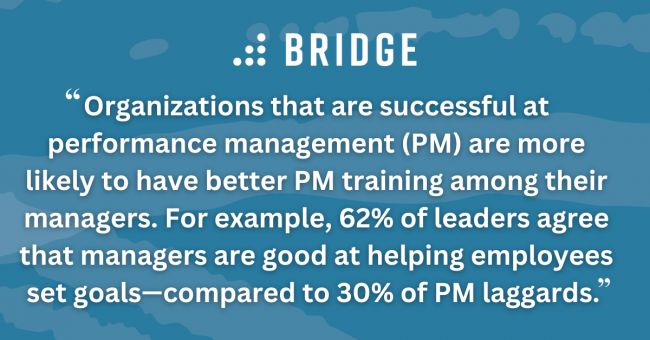
The Bridge Perspective: Invest in Easy-to-Use Performance Management Technology
To address the question of management-level PM training and accountability, it’s worth looking at the practices of PM leaders.
The report confirms that organizations that are successful at performance management are more likely to have better PM training among their managers. For example, 62% of leaders agree that managers are good at helping employees set goals—compared to 30% of PM laggards. So, what do the leaders do differently?
One key difference lies in the technology they employ. PM leaders are significantly more likely to use PM tech to a high or very high degree, and there’s no question that a good performance management system can facilitate managers who aren’t sure where to start.
The Bridge platform, for example, makes it easier for managers to engage in conversations. It recommends performance questions with sample answers and offers a template structure for 1:1 meetings, facilitating continuous feedback even among the 68% of organizations whose managers struggle with PM chats.
KEEP READING | ‘Feel the Benefits of Continuous Feedback With These 4 Approaches’
Takeaway 2: Manage Performance Management Systems Aren’t Well Integrated With Learning Management Systems
While PM tech is clearly a vital piece of the PM puzzle, it’s not enough to have the tools—you also need to make sure you can use them. As per the report, while 80% of organizations use digital technologies for performance management purposes, those technologies don’t always live up to their potential.
For one thing, only around half of that majority (42%) use their PM tech to a high or very high degree. For another thing, only 47% find their PM tech easy to use.
In that light, it’s no wonder that organizations aren’t using PM technology to its fullest. Only 34% of respondents said that their PM tech tracks training and development achievements, only 28% said that it aids training and development at all, and a paltry 18% said that their system can integrate with third-party solutions like learning management systems.
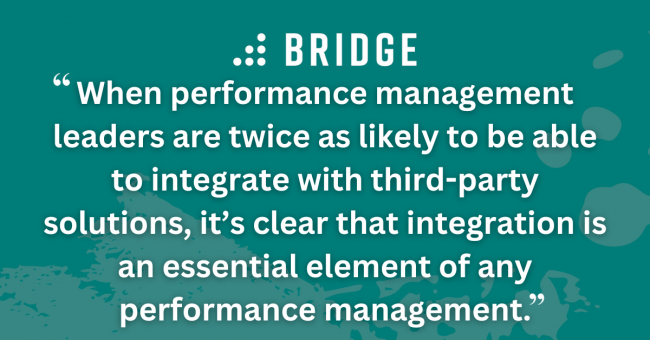
The Bridge Perspective: A Unified Learning and Performance Infrastructure Is Essential
Putting LMS integration at the heart of your PM technology is key to effective performance management. Improvements to employee performance will inevitably involve learning and development goals, and measuring your people’s progress on that journey will be greatly facilitated by the ability to track their L&D-related progress.
The appetite for integration is clearly present among the report’s respondents: no doubt that’s why 51% of organizations opt to bundle a performance management module within their HRIS. Plus, when performance management leaders are twice as likely to be able to integrate with third-party solutions, it’s clear that integration is an essential element of any performance management toolkit.
That said, it’s important to channel that appetite for integration in the right direction by ensuring that, within your HR tech infrastructure, your learning and performance technology can act as a cohesive whole. For example, your employees’ performance goals might include learning from your LMS that you can discuss as part of your PM conversations.
MORE FROM THE BLOG | ‘10 Performance Management Trends Shaping HR in 2023’
Takeaway 3: Organizations Lack Accurate Performance Management Metrics
Performance goals aren’t just a handy way to illustrate the value of LMS integrations—they’re also an essential performance metric.
This is worth establishing, since (according to the report) plenty of organizations lack robust performance metrics. Just 30% of respondents felt that their performance process accurately portrays employee performance, which speaks to a widespread inability to effectively measure the impact of PM processes. No wonder only 13% of respondents felt performance management was crucial for overall business performance: they lack visibility over its benefits.
Part of the problem is, as we’ve seen, the fact that the most common PM metric (at a huge 66%) is manager ratings, which are subject to bias. There’s a similar story to be told of employee self-ratings, which, at 55%, form the second-most common metric. While self-ratings have their part to play, they’re no substitute for objective, measurable performance factors.
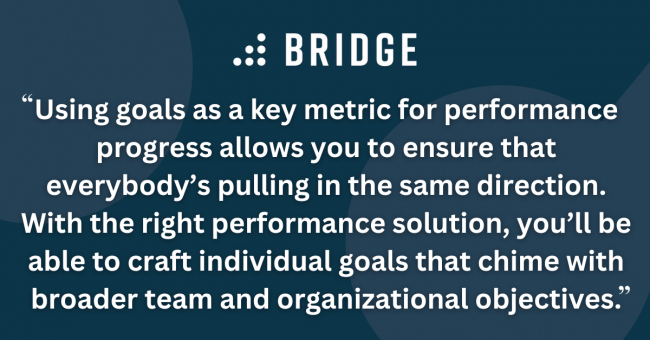
The Bridge Perspective: Prioritize Goal-Setting Practices That Promote Organization-Wide Alignment
The saving grace in the PM metric landscape is that goal achievement was found to be the third most popular choice. This is a great way to keep track of employee performance: it allows you to introduce a quantifiable means of tracking performance progress while still giving you the flexibility to account for the unique needs of each employee.
Better still, the most widely-used goal-setting method was the SMART system, which encourages employees to set goals that are specific, measurable, achievable, relevant, and time-bound. We’re advocates of the SMARTER approach, in which goals are also evaluated and revised.
Crucially, using goals as a metric for performance progress also allows you to ensure that everybody’s pulling in the same direction. With the right performance solution, you’ll be able to craft individual goals that chime with broader team and organizational objectives, allowing you to meet individual needs while also factoring in the macro goals that drive your entire organization.
This is the perfect way to ensure that individual employee performance is both accurately portrayed and meaningfully impactful.
RELATED READING | ‘What Are SMARTER Goals and How Do They Help Measure Employee Productivity?’
Takeaway 4: OrgaPerformance Management Leaders Enjoy a Range of Benefits
While the report reveals a laundry list of PM-related deficiencies, it also highlights the benefits that come hand-in-hand with getting performance management right.
The report’s PM leaders see far better outcomes than organizations that don’t excel in performance management. In particular, PM leaders:
- Are nearly four times more likely to achieve better employee development
- Are around four times more likely to enjoy better employee performance
There’s no question that high-performing and constantly developing employees can only lead to better business outcomes—which means there are real stakes to getting performance management right.
The Bridge Perspective: Performance Technology Can Help You Emulate PM Leaders
It might not be surprising that PM leaders enjoy better performance and development, but that’s all the more reason to take a look at how they do it. Identifying good performance practices is the first step on the path toward good performance management.
As the report points out, PM leaders are four times more likely to conduct performance reviews and appraisals four or more times per year. This is a practice that an intuitive performance management system can encourage. By making it easier to conduct these conversations, and by incorporating app-based push notifications to ensure they don’t fall by the wayside, the right tech will have you following top performance practices in no time.
Similarly, PM leaders are twice as likely to be good at helping employees set goals, which, as we’ve discussed, is a task any good performance management system can facilitate.
In fact, perhaps most tellingly, the organizations that excel the most at performance management are twice as likely to say that their managers are satisfied with their performance management system. This demonstrates the vital role that PM technology plays in achieving better performance, stronger development, and all the positive business outcomes that follow.
Become a Performance Management Leader With Bridge
Discover how Bridge’s performance management system can help you effortlessly follow in the footsteps of today’s performance leaders by requesting a demo—or latest video all about our solution.
